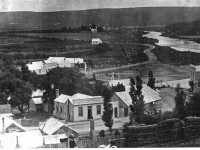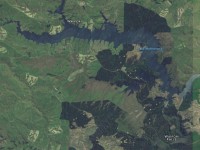

Extracted from David Still:
THE WAIPORI GOLDFIELD: A Brief History
Gold discovered at Waipori
On 17th December 1861, [a certain] O’Hara and his mates reported a new gold field at Waipori. … and on the 20th December 1861 … about 400 miners working on the banks of the Lammerlaw Creek and its tributaries. Soon there were tents and some stores scattered all along the creek, and the entire population was calculated to be about 2,000.
The Township of Waipori
The place called the township was a wretched site, perched on the cone of two small hills, difficult of ascent and limited in area. Five miles further down at the junction of the Waipori River and Lammerlaw Creek there began to form another township on level ground near the old road and ford, and so the town (first known as Waipori Junction) was born.
The School
Mr. James Edward Wilson was appointed as teacher in 1866 and later under his real name of James Payne Baker. … In 1911, the school was reduced to one teacher from then on. … and in 1925 Catherine O’Reilly.
Lake Mahinerangi is a small lake formed when a dam was built on the Waipori River for hydroelectric generation.
The Waipori hydro-electric scheme includes a network of four dams and power stations and produces a maximum output of 84 MW.
The lake itself, was named after Olive Mahinerangi Barnett, the daughter of William Barnett, mayor of Dunedin 1911-1912.
Lake Mahinerangi
The tributaries of the Waipori River are in the Lammerlaw Range. The river descends gradually until the Waipori Gorge, where it suddenly drops 222 metres in approximately 4,000 metres. Which makes the gorge an ideal site for a hydro-electric scheme.
Lake Mahinerangi was formed by a 20.4 metre high dam, with work beginning in 1927 and completed in 1931, with a powerhouse of 3,000 kW capacity. The new lake submerged the mining township of Waipori and mining interests had actively opposed the building of the dam as Waipori Flat was still being actively mined. In 1920, the Dunedin City Corporation Empowering Act was successfully pushed through Parliament to enable the use of the Waipori River as a hydro-electric reservoir.
The Mahinerangi Dam was increased to its final height of 33.5 metres in 1946. By 1955, two more generating stations had been built downstream from the original powerhouse. There have been further replacements and additions to generating capacity between the 1960s and 1980s.
Ref: http://www.geocaching.com/geocache/GC40XTJ_lake-mahinerangi-otago?guid=2a93463a-0c4d-40e0-a083-d45b514a7aa6
Victoria University of Wellington Library
Victoria University of Wellington logo
New Zealand Electronic Text Collection
Home
About
Help
[advanced search]
▼ About this page
Title: The Cyclopedia of New Zealand [Otago & Southland Provincial Districts]
Author: Cyclopedia Company Limited
Publication details: The Cyclopedia Company, Limited, 1905, Christchurch
Part of: The Cyclopedia of New Zealand
Creative Commons Attribution-Share Alike 3.0 New Zealand Licence
License: Creative Commons Attribution-Share Alike 3.0 New Zealand Licence
Share:
Other formats
TEI XML file ePub eBook file
Connect
mail icontwitter iconBlogspot iconrss icon
▼ Browse collection
People
Projects
Works
Subjects
Autobiography; Biography; Journals; Correspondence
Contemporary Māori and Pacific Islands
Historical Māori and Pacific Islands
Language
Literary Criticism and History
Literature
New Zealand History
Science and Natural History
The Cyclopedia of New Zealand [Otago & Southland Provincial Districts]
Waipori
Previous Section | Table of Contents | Up | Next Section
Waipori.
Waipori is a scattered mining district, and forms the eastern portion of the county of Tuapeka. The township is situated about the centre of the mining district, and is fourteen miles from Lawrence, and twenty-five to the west of Outram. It is connected with Lawrence by a coach service, which carries the mails. The township stands at an elevation of about 1300 feet above sea level. Quartz mining has been carried on at Waipori since the early days of settlement, and during recent years the most modern systems of dredging and hydraulic elevating have also been in vogue. The township has a post and telegraph office, a school, hotels, and stores.
Waipori In 1898.
Waipori In 1898.
The Waipori Post And Telegraph Office is at present carried on in the business premises of Mr. F. W. Knight. Mails are despatched and received thrice weekly. Telegraph messages are transmitted at the usual rates by telephone to Lawrence. There is a money order office, but no savings bank.
Mr. Fred William Knight , J.P., Postmaster and Telegraphist, at Waipori, was born at Shirley, in Hampshire, England, in 1856. When four years of age he came to Victoria with his parents by the ship “Essex.” In 1862 the family came to New Zealand in the steamer “Aldinga,” and went to Waitahuna, where Mr. William Knight, father of Mr. Knight, carried on business as a baker with much success. The family then went to Miller’s Flat, and in October, 1864, removed to Waipori, where Mr. page 692 Knight has resided ever since, and has been intimately connected with nearly all the public affairs of the district. For over twenty years he has been a member of the local school committee, and has been many times its chairman. In 1887, Mr. Knight became a member of the Waipori Lodge of Oddfellows, in which he attained the highest position, and has for about twenty years held the office of permanent secretary. He now usually represents the lodge at the district meetings. In February, 1884, he was appointed a Justice of the Peace, and in that capacity he acts as deputy-coroner for the district. Mr. Knight was one of the founders and first chairman of the present Miners’ Association. For several years he represented Waipori riding in the Tuapeka County Council. Besides being a Justice of the Peace, and postmaster and telegraphist, he now holds an appointment as clerk of the Wardon’s Court, and formerly he held the office of Registrar of Births, Deaths and Marriages. Mr. Knight was a member of the Waitahuna licensing committee, when that body existed, and he afterwards contested the Taieri licensing election and obtained over 600 votes, but was not successful. He was appointed a trustee of the Waipori cemetery in 1884, and still holds that office. Since 1882 he has carried on business at Waipori as a general storekeeper; he also has the sole bakery business of the district, and does a fair trade in butchering. Mr. Knight having lived in goldmining districts nearly all his life, takes great interest in everything pertaining to the mining industry. He has owned some valuable mining properties, including several water-races and two quartz crushing batteries, and he also owns a good deal of other property in Waipori. In 1884 he married Mary, third daughter of Mr. Richard Lean, of “The Rocks,” Port Chalmers, and has five sons and two daughters. He has recently purchased, from his father-in-law, the fine property at Port Chalmers, known as “The Rocks,” and will probably settle there if he ever leaves Waipori.
Mr. F. W. Knight.
Mr. F. W. Knight.
“The Rocks,” Port Chalmers, Property Of Mr. F. W. Knight, Waipori.
“The Rocks,” Port Chalmers, Property Of Mr. F. W. Knight, Waipori.
Bridge Hotel (W. E. S. Knight, proprietor), Waipori. This is a two-storey wooden building, containing thirty-five rooms, including a bathroom, billiard-room, three sitting-rooms, and a large dining-room. There is ample stable accommodation attached to the premises.
page 693
Mr. Samuel Caudwell , sometime Proprietor of the Bridge Hotel, Waipori, was born in Nottinghamshire, England, in 1833. In 1852 he came out to Victoria, and went to Castlemaine, Mount Alexander, Bendigo, Sandy Creek, McIntyre’s, Mount Maldon and all the principal goldfields. Within two months of the discovery of Gabriel’s Gully, he landed in New Zealand. He immediately went to the field, and paid one shilling for the carriage of every one pound of food, tools, etc. For some time he was fairly successful, and he returned to Australia, where he became interested in various quartz mining ventures. About Christmas, 1866, he came back to New Zealand, and ever after resided at Waipori. On his return he engaged in ground sluicing, but sold out all his rights, waterraces, etc., and became a hotelkeeper. Mr. Caudwell was chairman of the local school committee. During a mining boom he and others sold the O.P.Q. claim to the New Zealand Minerals Company, Ltd., for £5000 cash. While he was on the Victorian goldfields Mr. Caudwell paid as much as £160 per ton for freight from Melbourne to Bendigo, and bought flour at £25 per sack, butter 6s per pound, sugar 3s per pound, and salt 3s per pound. Mrs Caudwell came to New Zealand from Victoria in the early sixties. Mr. Caudwell died on the 8th of December, 1901.
Mr. William J. Farrell , formerly owner of the Waipori Deep Lead, is a native of Belfast, Ireland, and arrived in New Zealand in 1874. Shortly after landing he joined an exploration party on the West Coast, but returned to Dunedin and entered commercial life, from which he retired in 1888. Mr. Farrell invested capital in the Macetown district, and for years was the managing director of several companies. In 1882 he made a special journey to America, for the purpose of acquiring a knowledge of modern improvements in mining. With that end in view, he visited Colorado and Nevada, and other great mining centres. In two years he returned to the colonies and acquired the “Homeward Bound,” “Lady Fayre,” “Golden Treasure,” “Victor Emmanuel,” “Morning Star,” “Black Angel,” “Garibaldi,” and “Maryborough” mines, and other properties in the Macetown district. Following in the footsteps of the late Mr. J. C. Brown, M.H.R., who floated the Blue Spur mine, Lawrence, Mr. Farrell went to London, and successfully floated one of his group, known as the Premier Consolidated Gold Mining Company, Ltd., for the sum of £70,000. This company is now named the Glenrock, Ltd., and with a total expenditure of about £18,000, it had (up to the end of 1899) obtained gold to the value of £35,000, and was still working at a handsome profit. Mr. Farrell considered that this success was largely due to working the mine under the “Incline” principle, which was at first termed a Yankee notion. During Mr. Farrell’s absence from the colony, this plan was allowed to drop, but when he returned, he, as managing director, insisted on its resumption, and brought it to a successful issue. The Deep Lead at Waipori was another mine the development of which bears witness to Mr. Farrell’s resourceful enterprise. Mr. Farrell also invested in tin mines in the Rexhill district, Tasmania, where, according to the Government Geologist’s official report, “It is nothing unusual to find large blocks of tin which yield from sixty to seventy per cent, of pure metallic tin.”
Bridge Hotel, Waipori.
Bridge Hotel, Waipori.
Mr. W. J. Farrell.
Mr. W. J. Farrell.
Previous Section | Table of Contents | Up | Next Section
Home | Advanced Search | About | Help
© 2014 Victoria University of Wellington | Contact us | Conditions of use
